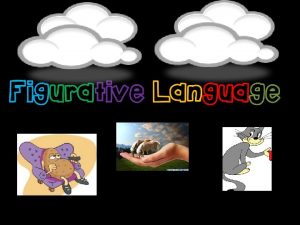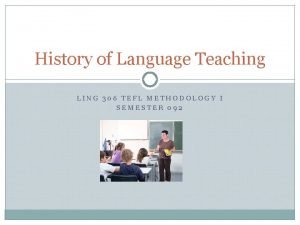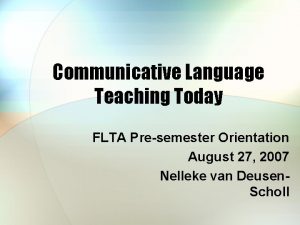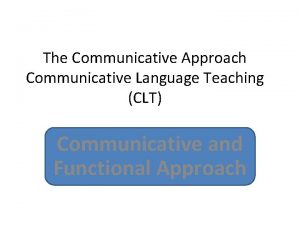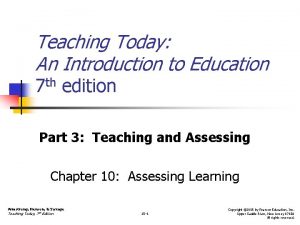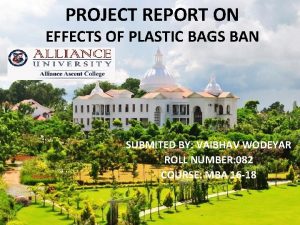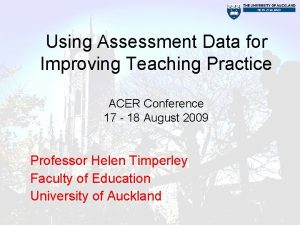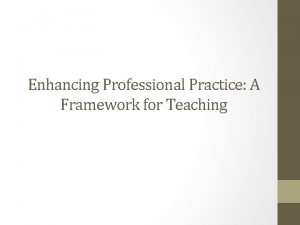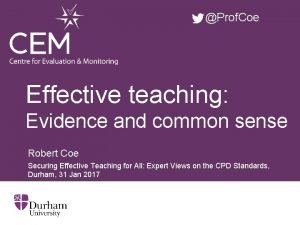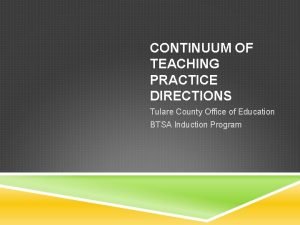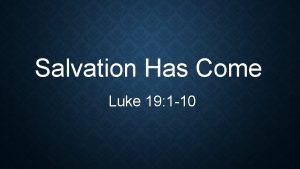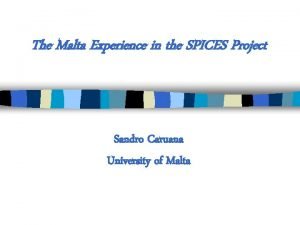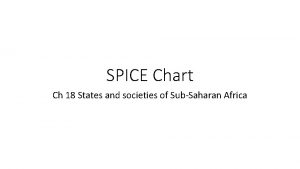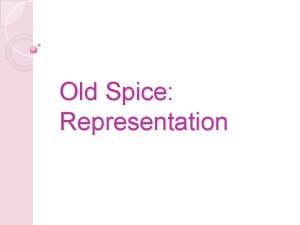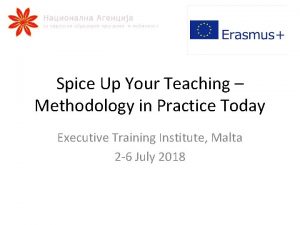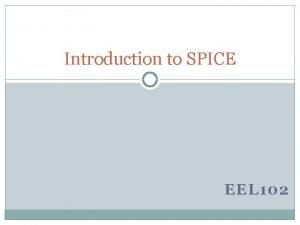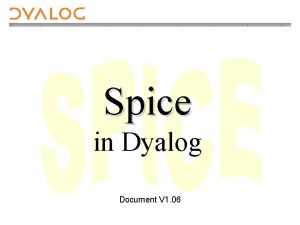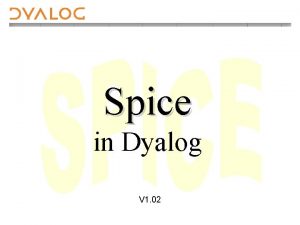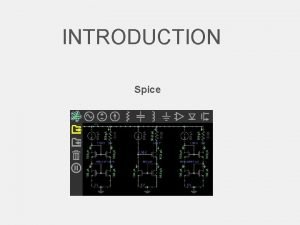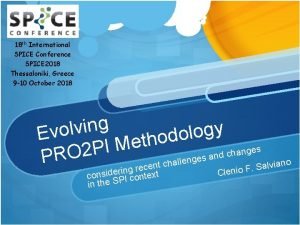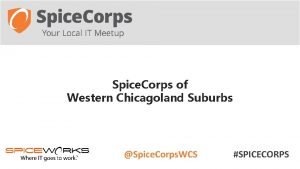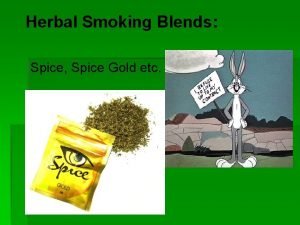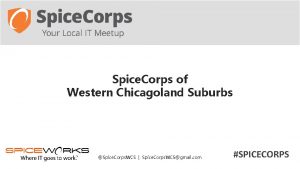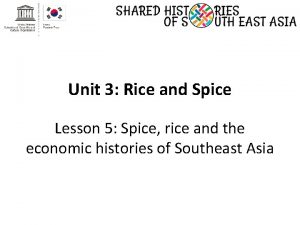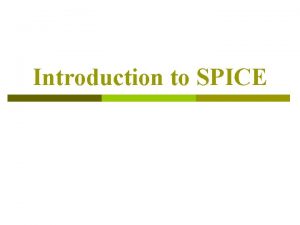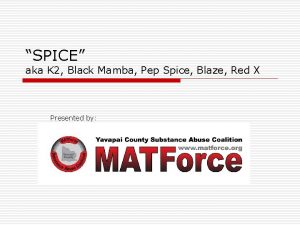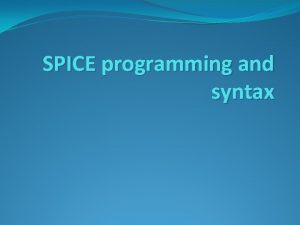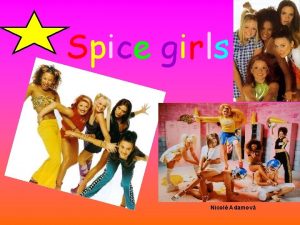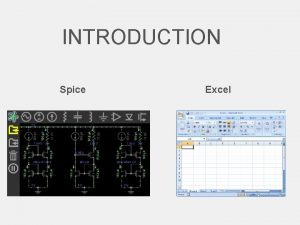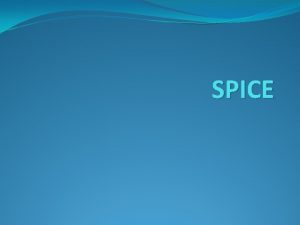Spice Up Your Teaching Methodology in Practice Today






























- Slides: 30

Spice Up Your Teaching – Methodology in Practice Today Executive Training Institute, Malta 2 -6 July 2018



Teacher Valerie Zammit

Course programme • • • Engaging the Learner: What motivates today’s students? Task-based learning Learner Styles and Multiple intelligences Collocations Songs and Music Tell me a story Using computers and exploiting the Internet Using videos and DVDs Cuisenaire rods Grammar practice Co-operative learning

The teacher is: • • A sales person A ringmaster in a circus A driving instructor An encylopaedia A social worker An actor A pied piper A prison warder

The classroom is • • A greenhouse A runway A workshop A prison A courtroom A minefield A factory A playground

Very few basic points: • The Holy Grail for every teacher is to motivate their students • Task-based learning engages students’ attention most

NLP (Neuro Linguistic Programming) 1. 2. How we think (NEURO) How we use language to make sense of the world to conceptualise experience (LINGUISTIC) 3. → the brain can be trained (behaviour and emotion) (PROGRAMMING) • “NLPhas been around in language teaching longer than we may realise. Those teachers who incorporate elements of suggestopedia, community language learning, music, drama and body language into their lessons are already drawing on NLP as it stood twenty years ago. ” • Teachers must understand that what is actually learnt by individuals is dictated by their own personal filters (beliefs', 'values', 'decisions' and 'memories‘)

NLP • Closely connected to Multiple Intelligences: - Visual - Auditory - Kinaesthetic (VAK – used often, more practical, compared to the 8 intelligences) - Auditory Internal (self talk)

Dictation • John was driving along a quiet street at ____. The weather was _____ and he was heading to ____, because he ______________. He was feeling _____ because ________. John was totally lost in thought when suddenly __________. (It can be done as an opening paragraph of a story writing. It boosts confidence of weaker ss, who don’t know how to start).

Dictogloss • Example Learners discuss pollution. Then the teacher reads a short text on the pollution to the class, who just listen. The teacher reads the text again, and the learners take notes. In groups, the learners reconstruct the text. “The sources of pollution are numerous. The identification of these different pollutants and their effects on ecosystems is complex. They can come from natural disasters or the result of human activity, such as oil spills, chemical spills, nuclear accidents. . . These can have terrible consequences on people and the planet where they live: destruction of the biodiversity, increased mortality of the human and animal species, destruction of natural habitat, damage caused to the quality of soil, water and air. . . ” • Dictogloss is often regarded as a multiple skills activity. Learners practise listening, writing and speaking (by working in groups) and use vocabulary, grammar and discourse systems in order to complete the task.

Picture Dictation • In the middle of the picture there is a big house…. The house has a door and two windows…. on the roof of the house there is a chimney…. . In the top right hand side of the picture there is a very big sun. . Beside the house and under the sun there is a little hill…. (handout)


Cuisenaire Rods ( early 1950 s) Belgian primary school teacher Georges Cuisenaire • • • Memorable Appeal to VAK students Encourage cognitive learning Aren’t seen as ‘work’ but as fun Increase motivation Encourage rapport between SS and T

Cuisenaire Rods




Cuisenaire rods • Create a scene and hide it from your partner. Describe it to them and they recreate it at the same time • Construct a typical street and ask for directions • Ss choose a colour as a representation of their current mood and talk about it • Grammar structures (e. g. colours stand for auxiliaries)

Cuisenaire rods • Error correction (green rods are used for correct sentences and red ones for wrong) • Colour-coding parts of speech (e. g. nouns are green, verbs red, prepositions blue, etc) • Telling the time (a clock is drawn on the board, ss stick the rods to tell the time) • Describing a room (use rods to build up pictures as you speak)

Vocaboxes (vocaenvelopes) • At the end of each vocabulary lesson - either you or the students should write words from the lesson on different cards. So, you may end up with ten words on ten cards and these cards are then placed in the vocabulary box. • Or simply take a photo of the board at the end of the class • If you have time, and with stronger classes, you, or the students, may write a definition of the word on the reverse of each card. • This box just becomes so flexible in how you can use it. It could be at the end of the lesson. For example 'You can't leave the classroom until you've defined two words that are in the box'. Vocabulary boxes are fantastic and they take so little time but provide so many activities.

Concordances • Concordancing is a means of accessing a corpus of text to show any given word or phrase in the text is used in the immediate contexts in which it appears (BNC - http: //www. natcorp. ox. ac. uk/

Stories • A Fable of a Bird and her Chicks

Stories • The Loch Ness Monster - a guided visualisation

Stories • T dictates a list of 18 verbs, ss come up with a story, using only those 18 verbs in the order they were dictated: was; went; bought; cheated; fell; hurt; shouted; ran away; thought; tried; smelled; looked for; jumped; couldn’t manage; cried out; held; felt; had

Exploiting the Internet https: //www. cia. gov Suggested tasks: 1. The World Fact Book – compare and contrast 2 countries (handout) https: //www. cia. gov/library/publications/the-world -factbook/ 2. The World Fact Book - Flags of the World Pairwork: ss choose a flag and describe it to each other (handout)

Videos • http: //lessonstream. org/ • https: //www. youtube. com/watch? v=nhz. Mh. UIL 0 v. U • https: //www. youtube. com/watch? v=Ut. Pkxz. HKL pk

Mime • SS must mime a whole sentence (might be with a particular structure being taught). Every word is represented with a blank on the board. Every correct word is written on the board until the whole sentence is constructed or guessed

 What does figurative language mean
What does figurative language mean For today's meeting
For today's meeting We are going today
We are going today Today meeting or today's meeting
Today meeting or today's meeting Characteristic of fingerprint
Characteristic of fingerprint Today's lesson or today lesson
Today's lesson or today lesson Today's lesson or today lesson
Today's lesson or today lesson History of language teaching methodology
History of language teaching methodology Jack richards communicative language teaching today
Jack richards communicative language teaching today Clt activities
Clt activities Teaching today an introduction to education
Teaching today an introduction to education Micro teaching is a scaled down encounter
Micro teaching is a scaled down encounter Give us your hungry your tired your poor
Give us your hungry your tired your poor Impact of use of plastic bags on environment methodology
Impact of use of plastic bags on environment methodology Using assessment data for improving teaching practice
Using assessment data for improving teaching practice Enhancing professional practice a framework for teaching
Enhancing professional practice a framework for teaching Educational psychology theory and practice
Educational psychology theory and practice Singapore teaching practice
Singapore teaching practice Effective teaching evidence and practice
Effective teaching evidence and practice Continuum of teaching practice
Continuum of teaching practice When did you finish your homework
When did you finish your homework Today salvation has come to your house
Today salvation has come to your house Create your azure free account today
Create your azure free account today Raguni spice
Raguni spice Schneider electric my learning link
Schneider electric my learning link Pure capsaicin
Pure capsaicin Theme spice
Theme spice Great zimbabwe spice chart
Great zimbabwe spice chart Chapter 15
Chapter 15 Han china spice chart
Han china spice chart Old spice bahamas advert
Old spice bahamas advert
